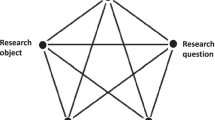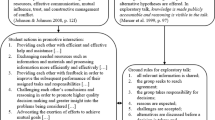Abstract
Analyzing and designing productive group work and effective communication constitute ongoing research interests in mathematics education. In this article we contribute to this research by using and developing a newly introduced analytical approach for examining effective communication within group work in mathematics education. By using data from 12 to 13-year old students playing a dice game as well as from a group of university students working with a proof by induction, the article shows how the link between visual mediators and technical terms is crucial in students’ attempts to communicate effectively. The critical evaluation of visual mediators and technical terms, and of links between them, is useful for researchers interested in analyzing effective communication and designing environments providing opportunities for students to learn mathematics.




Similar content being viewed by others
Notes
The concept of effective communication is used in accordance with Sfard and Kieran (2001), and is discussed and defined below.
References
Amigues, R. (1988). Peer interaction in solving physics problems: Socio cognitive confrontation and metacognitive aspects. Journal of Experimental Child Psychology, 45(1), 141–158.
Arcavi, A. (2003). The role of visual representations in the learning of mathematics. Educational Studies in Mathematics, 52, 215–241.
Barron, B. (2003). When smart groups fail. The Journal of the Learning Sciences, 12(3), 307–359.
Bergqvist, K., & Säljö, R. (1994). Conceptually blindfolded in the optics laboratory: Dilemmas of inductive learning. European Journal of Psychology in Education, 9, 149–158.
Bryman, A. (2004). Social research methods (2nd ed.). Oxford, UK: Oxford University Press.
Cobb, P. (1999). Individual and collective mathematical learning: The case of statistical data analysis. Mathematical Thinking and Learning, 1, 5–43.
Coleman, E. (1998). Using explanatory knowledge during collaborative problem solving in science. The Journal of the Learning Sciences, 7, 387–427.
David, M. M., & Tomaz, V. S. (2012). The role of visual representations for structuring classroom mathematical activity. Educational Studies in Mathematics, 80(3), 413–431.
Grice, H. P. (1968). Logic and conversation: The William James lectures. Cambridge, MA: Harvard University Press.
Howe, C. (2009). Expert support for group work in elementary science: The role of consensus. In B. Schwarz, T. Dreyfus, & R. Hershkowitz (Eds.), Transformation of knowledge through classroom interaction (pp. 93–104). New York: Routledge.
Kieran, C. (2001). The mathematical discourse of 13-year-old partnered problem solving and its relation to the mathematics that emerges. Educational Studies in Mathematics, 46, 187–228.
Kieran, C., & Dreyfus, T. (1998). Collaborative versus individual problem solving: Entering another’s universe of thought. In A. Olivier & K. Newstead (Eds.), Proceedings of the 22nd international conference for the Psychology of Mathematics Education (Vol. 3, pp. 112–119). Stellenbosch, South Africa: PME.
Linn, M. C., & Burbules, N. C. (1993). Construction of knowledge and group learning. In K. Tobin (Ed.), The practice of constructivism in science education (pp. 91–119). Washington, DC: American Association for the Advancement of Science.
Martin, L., Towers, J., & Pirie, S. (2005). Collective mathematical understanding as improvisation. Mathematical Thinking and Learning, 8(2), 149–183.
Mason, J. (1998). Enabling teachers to be real teachers: Necessary levels of awareness and structure of attention. Journal of Mathematics Teacher Education, 1, 243–267.
McCrone, S. S. (2005). The development of mathematical discussion: An investigation in a fifth grade classroom. Mathematical Thinking and Learning, 7(2), 111–133.
Nilsson, P. (2009). Conceptual variation and coordination in probability reasoning. Journal of Mathematical Behavior, 28, 247–261.
Nilsson, P., & Ryve, A. (2010). Focal event, contextualization, and effective communication in the mathematics classroom. Educational Studies in Mathematics, 74, 241–258.
Pettersson, K. (2008). Växelverkan mellan intuitiva idéer och formella resonemang: En fallstudie av universitetsstudenters arbete med en analysuppgift [Interplay between intuitive ideas and formal justification. A case study of university students’ work on a calculus task]. Nordic Studies in Mathematics Education, 13(1), 29–50.
Prusak, N., Hershkowitz, R., & Schwarz, B. (2012). From visual reasoning to logical necessity through argumentative design. Educational Studies in Mathematics, 79, 19–40.
Radford, L. (2008). “No! He starts walking backwards!”: Interpreting motion graphs and the question of space, place, and distance. ZDM, 41, 467–480.
Radford, L. (2011). Book Review: Classroom interaction: Why is it good, really? In B. Schwarz, T. Dreyfus & R. Hershkowitz (Eds.) (2009) Transformation of knowledge through classroom interaction. Educational Studies in Mathematics, 76, 101–115.
Roth, W.-M., & Lee, Y. J. (2004). Interpreting unfamiliar graphs: A generative activity theoretical model. Educational Studies in Mathematics, 57, 265–290.
Ryve, A. (2006). Making explicit the analysis of students’ mathematical discourses: Revisiting a newly developed methodological framework. Educational Studies in Mathematics, 62, 191–210.
Ryve, A. (2011). Discourse research in mathematics education: A critical evaluation of 108 journal articles. Journal for Research in Mathematics Education, 42, 167–198.
Ryve, A., Larsson, M., & Nilsson, P. (2011). Analyzing content and participation in classroom discourse: Dimensions of variation, mediating tools, and conceptual accountability. Scandinavian Journal of Educational Research. Advance online publication. doi: 10.1080/00313831.2011.628689
Ryve, A., Nilsson, P., & Mason, J. (2012). Establishing mathematics for teaching within classroom interactions in teacher education. Educational Studies in Mathematics, 81(1), 1–14.
Salomon, G., & Globerson, T. (1989). When teams do not function the way they ought to. In N. M. Webb (Ed.), Peer interaction, problem-solving, and cognition: Multidisciplinary perspectives (pp. 89–99). Oxford, UK: Pergamon Press.
Schwarz, B., Dreyfus, T., & Hershkowitz, R. (Eds.). (2009). Transformation of knowledge through classroom interaction. New York: Routledge.
Sfard, A. (2001). There is more to the discourse than meets the ears: Looking at thinking as communication to learn more about mathematical learning. Educational Studies in Mathematics, 46, 13–57.
Sfard, A. (2008). Thinking as communicating: Human development, the growth of discourses, and mathematizing. Cambridge, UK: Cambridge University Press.
Sfard, A., & Kieran, C. (2001). Cognition as communication: Rethinking learning-by-talking through multi-faceted analysis of students’ mathematical interactions. Mind, Culture, and Activity, 8, 42–76.
Valero, P., & Stentoft, D. (2010). The ‘post’ move of critical mathematics education. In A. O. Ravn & P. Valero (Eds.), Critical mathematics education: Past, present, future (pp. 183–195). Rotterdam: Sense.
Weber, K., Maher, C., Powell, A., & Lee, H. S. (2008). Learning opportunities from group discussions: Warrants become the objects of debate. Educational Studies in Mathematics, 68, 247–261.
Wegerif, R., Boero, P., Andriessen, J., & Forman, E. (2009). A dialogue on dialogue and its place within education. In B. Schwarz, T. Dreyfus, & R. Hershkowitz (Eds.), Transformation of knowledge through classroom interaction (pp. 184–199). New York: Routledge.
Wertsch, J. V. (2007). Mediation. In H. Daniels, M. Cole, & J. V. Wertsch (Eds.), The Cambridge companion to Vygotsky (pp. 178–192). Cambridge: Cambridge University Press.
Wertsch, J. V., & Kazak, S. (2011). Saying more than you know in instructional settings. In T. Koschmann (Ed.), Theorizing learning practice (pp. 134–167). New York: Springer.
West, C., & Zimmerman, D. H. (1983). Small insults: A study of interruptions in cross-sex conversations between unacquainted persons. In B. Thorne, C. Kramarae, & N. Henley (Eds.), Language, gender and society (pp. 103–117). Rowley, MA: Newbury House.
Author information
Authors and Affiliations
Corresponding author
Additional information
Ryve is the first author and Nilsson and Pettersson have contributed equally to the article.
Rights and permissions
About this article
Cite this article
Ryve, A., Nilsson, P. & Pettersson, K. Analyzing effective communication in mathematics group work: The role of visual mediators and technical terms. Educ Stud Math 82, 497–514 (2013). https://doi.org/10.1007/s10649-012-9442-6
Published:
Issue Date:
DOI: https://doi.org/10.1007/s10649-012-9442-6




